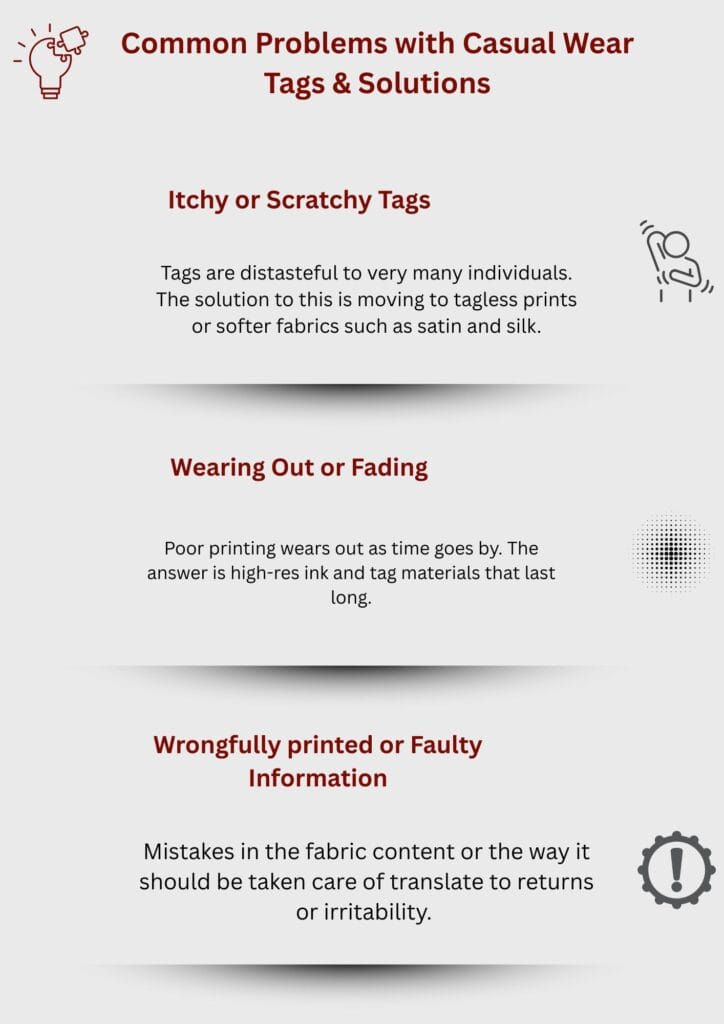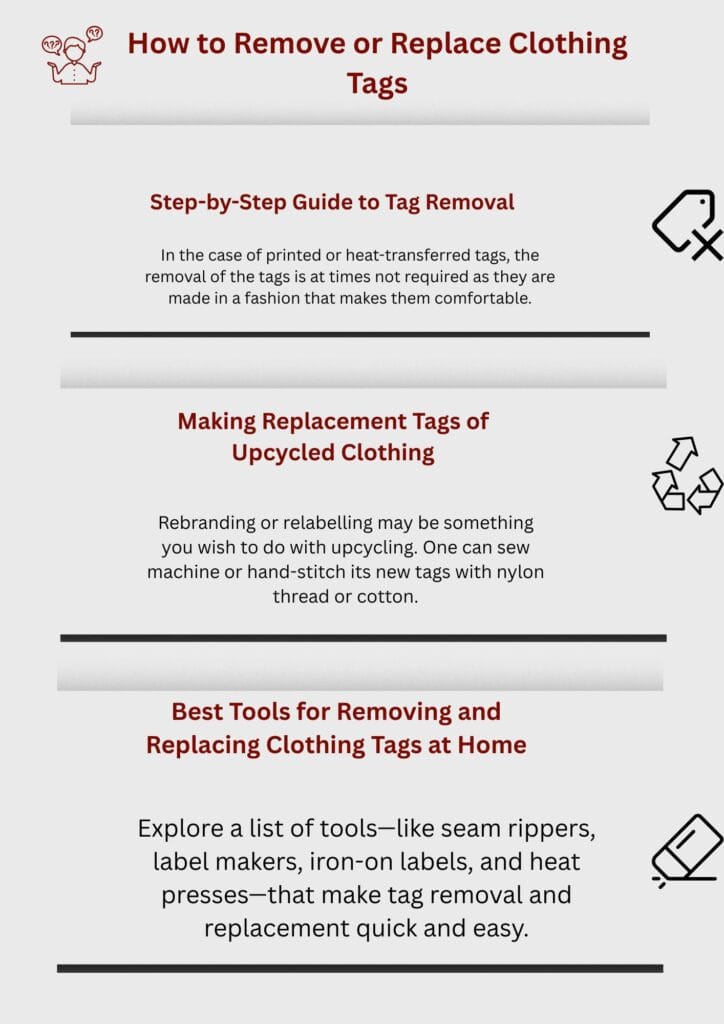Introduction
What are casual wear tags?
The casual wear tags can be small pieces of cloth, paper or electronic items and they are stuck to the garments. They pass information that is important like the brand names, how to care, fabric content and sizes. Though these tags might be considered as insignificant, it gives vital information to the consumer and the manufacturer.
A tag is inseparable with casual clothing today. They not only incorporate a branding aspect but they also enable product transparency. Be it sewn on or heat-pressed, tags show quality and the sense of detail in daily attires.
The significance of Tagging on Clothing
Clothing labels have more than one purpose other than identification. To begin with, they portray the brand name, which provides logos or slogans that impress. Secondly, they have instructions on how to take care of it to guide quality in the garment. The last is style notes, including, on the one hand, minimalism design accents and, on the other, luxurious details.
Without these tags customers might not know how to select the right size or how to wash the garment or how to know where this garment is made. Therefore, tags are not indifferent to the world of fashion nowadays.
Types of Casual Wear Tags
Material Tags Composition of Fabrics and Sustainability
The tags that are provided on materials display the composition of the garment cotton, polyester, wool etc. Increasing brands provide the information on the sustainability, such as the recycled or organic origin of the fabric. This assists the eco-friendly customers to make better decisions.
The type of fabric known also tells about how to care and how long this product will last. The ease and fair production are the initial signs of material tags.
Brand Tags: logo marks and trendy brands
They commonly happen to be the most noticeable and modish brand tags. It can be embroidered logos, leather patches or printed ones. They do not only add a luxurious feel to casual clothes but also serve as strong brand advertising tools.
These labels facilitate the customers in distinguishing their preferred brands and fashions easily. They create as well emotional attachment and increase product loyalty.
Size Tags Standard v International Sizing
Size tags assist the consumers to purchase the right size. These can be in standard U.S. U.K., EU or Asian sizing. Others mix them up so as to make sense.
Proper and transparent sizing decreases the amount of returns and helps to increase the quality of shopping experiences. This is the reason why increasing numbers of brands have sewn size graphs or charts into the tags or tags.
Care Instruction Tags: Washing, Drying and Ironing Symbols
These labels apply internationally agreed symbols to indicate the way the item should be taken care of. To keep the garments in excellent condition, one must take account of washing temperatures, drying directions as well as ironing directions.
Shrinkage, fading or loss of fabric may result when care tags are ignored. That is what counts about such small, but powerful tags.
Green/Green/Environmental Tags
Biodegradability, recyclability, and reusability of tags are being embraced by brands that are environmental friendly. Others have hemp paper, soy ink or plastics made of corn starch. These labels limit the impact placed on the environment by fashion.
Modern customers are interested in ethical manufacturing and green activity, and such sustainable labels appeal to them.
What Is The Importance of Casual Wear Tag?
Brand Identity-The Impact of Tags Brand Recognition
Tags also play paramount roles in the process of conveying the story and missions of a brand. The brand will be easily recognized because of a special logo or similar style of tags. In a manner of time, certain customers come to identify particular designs and fonts with particular values of fashion.
Concisely, a smart casual wear label becomes a property of a brand.
Customer Experience: Comfort, Readability and usability
Casual fashion needs to be comfortable. It is due to this that soft and tagless or heat-pressed labels are now the favourites. The fonts used, the language, and the position of the tags have an impact on the satisfaction of the user.
The usability also consists in the accuracy of information provided, that is, when the tags assist customers to keep and know their clothes better.
Legal Compliance- Required Labeling Laws
Each nation has its labeling legislations. These are fiber composition, country of origin and care directions. Failure to comply results in punishment to brands.
A formal casual wear tag makes the product legitimate, safe to the consumers, and globally acceptable.
Recent Trends in the Casual Wear Labels
Minimalist and Tagless Designs
Contemporary fashion is inclined to smoothness. Most of the brands now utilize the heat-transfer labels or printed tags rather than stitched ones. These alternatives are smoother against the skin, and they are more refined.
Minimalist tags cut down the annoyance and smooth out the outfit of the garment design, which is ideal when it comes to comfort in everyday life.
IQ Tags: QR Codes, NFC, and Digital Functionality
Smart tags is the future of fashion labeling. They contain QR codes or NFC chips that lead to websites displaying the origin of the product, care guides or sustainability information.
The innovations are transparent and bridge the gap between digital-savvy consumers and brands upon close contact to each other.
Small brand Tagging of Small brands Personalized Tags
Different brands of fashions that are independent are making their tags unique. It makes it unique with custom fonts, shapes of tags, and stitching of messages.
This tendency enables small brands to show their originality and inventiveness without heavy marketing.
How to Choose the Right Tag for Casual Wear
Fabric Compatibility
The texture of the garment should match the right tag. As an example, thinner cotton shirts are ideal in woven or satin labels which are ideal in heavier jeans that can be in leather or embroidered one.
Tags are not supposed to irritate the skin and to be bulky. The easier a match is, the higher is the experience.
Durability: Wash and Wear Resistance
Tags need to be durable with many washings, drying and wearing. Good ink and cloth are used, which can not fade, tear or fray.
Long lasting tags retain their looks and legibility despite months of usage.
Appearing Attractive: Brand Matching Style
The tag design has to be equipped according to the theme of the clothing. A minimalistic brand will be using low-key printed tags whereas a vintage brand will be using plain old-school woven tags.
The appearance of the tag can supplement or detract your brand image thus design knewingly.
DIY & Custom Casual Wear Tags
What is the Source to order custom tags?
Companies such as Etsy, Alibaba, and local manufacturers have a custom tag service. They give bulk order, material selection and sample selection.
When selecting a good supplier, it is important to use a credible one that guarantees quality and delay free provide of products.
How to Design Your Own Tags
Designing Your Own Tags The above designs do not display much imagination, and it is not difficult to make up your own tags.
Custom tag designs can be created using software such as Canva, and (Adobe) Illustrator. You are able to insert your message, logo and color scheme.
You can never overlook the issue of readability of fonts, as well as tags size when designing.
Best Materials for Handmade Clothing Tags
What to Use as Handmade Clothing Tags The best materials to use in crafting your clothing tag include cardstock, vegetable-tanned leather and fine-grained leather
Good tag materials include cotton twill, satin, Kraft paper and a woven polyester. They are flexible, wear long clothes, and have a semi-formal appearance.
DIYers can also use iron-on tags, or fabric markers, which are good when you have to do small quantities.
Common Problems with Casual Wear Tags & Solutions

Itchy or Scratchy Tags
Tags are distasteful to very many individuals. The solution to this is moving to tagless prints or softer fabrics such as satin and silk.
The place of tags also counts: locating at the hem or side seams can usually make them less uncomfortable.
Wearing Out or Fading
Poor printing wears out as time goes by. The answer is high-res ink and tag materials that last long. Such fabric labels as woven tags, e.g. are readable even after dozens of washings.
Early wear is also prevented by frequent quality tests in the production line.
Wrongfully printed or Faulty Information
Mistakes in the fabric content or the way it should be taken care of translate to returns or irritability. This is the reason why quality proofreading and pre-production tag tests are important.
Automation devices have also contributed to ensuring errors of people are now averted in mass production.
Sustainable & Ethical Tagging Practices
Options of Tag that is biodegradable
Eco-brands have replaced regular tags that were plastic or paper with compostable tags composed of kraft paper, cornstarch film or coconut fibers. These labels disintegrate with no contamination of landfills.
These initiatives are in line with the increased trend of c-conscious consumers seeking purer apparel.
Vegan & Cruelty-Free Labels
Others are leather-based or silk-based which are non-veg. But there are cruelty-free alternatives, such as plant-based leather labels or recycled polyester ones.
Numerous ethical brands are eager to call their labels as vegan.
The difference Big Brands are Making
Other companies such as H&M and Patagonia have adhered to sustainable labeling. They resort to recyclable tags and provide QR-code transparency of products.
These fashion houses are role models to the other fashion industry.
How to Remove or Replace Clothing Tags

Step-by-Step Guide to Tag Removal
- Act with small scissors or seam ripper.
- Cutout tenderly the stitches but not tear the fabric.
- Pinch the tag out.
- Smoothen out the area with iron, in case of emergency.
In the case of printed or heat-transferred tags, the removal of the tags is at times not required as they are made in a fashion that makes them comfortable.
Making Replacement Tags of Upcycled Clothing
Rebranding or relabelling may be something you wish to do with upcycling. One can sew machine or hand-stitch its new tags with nylon thread or cotton.
Put them in such a way that they do not bother as well as destroy the design of the garment.
Future of tags Casual Wear
Blockchain Blockchain Tags Digital Tags of Authenticity
It is possible to provide unique IDs of each garment with blockchain technology. These electronic labels disallow counterfeits and follow the history of the manufacture.
Blockchain is used in brands to certify origin, ethical sourcing and product lifecycle.
Augmented reality (AR) tags
AR tags put fancy into reality. Typing a tag in your phone unlocks viewing of styling inspirations, virtual fitting rooms, and an origin of fabric.
These smart labels are transforming the way we do our shopping and education on clothes.
Conclusion
The basic casual wear label is much more than a stitched-on after-thought however. It narrates, translates brand values, makes customers comfortable and brings future progress. As a designer, shopper or an entrepreneur, familiarity with these tags can make one appreciate fashion more.
Be sure to look at the label next time you wear a comfy tee or a comfortable hoodie, as well. It might happen that you look at everyday fashion in a completely new way.


